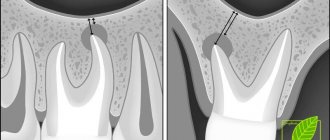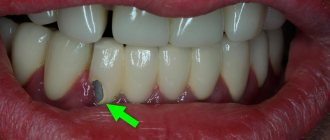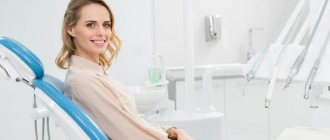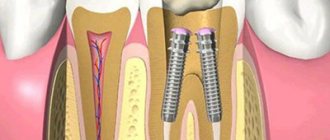- Tooth extraction
- Removal of a tooth cyst
- Bone tissue augmentation
- Resection of the apex of the tooth root
- Installation of a dental implant
- Installation of a mini-implant
Patients have more chronic dental diseases than acute ones. Advanced caries, pulpitis, periodontitis lead to the fact that after a few months or years the patient is faced with a neoplasm on the root of the tooth or its acute inflammation. In this case, resection helps to save the tooth.
When should tooth resection not be performed?
- The main condition for successful root resection is the presence of sufficient jaw bone volume in the patient - at least 5 mm, otherwise there is a risk of jaw fracture.
- A tooth root resection operation will be ineffective if the patient has chronic periodontitis and/or periodontitis, as well as mobility of the diseased tooth.
Tooth root resection is contraindicated if:
- Large cysts or granulomas, when they reach the size of a third of the tooth root or more.
- A completely destroyed dental crown, if the tooth cannot be replaced with prosthetics.
- Close proximity of the roots of healthy teeth.
- Severe mobility of the diseased tooth.
- Some common diseases, such as diabetes, blood diseases, heart diseases, immunodeficiency conditions.
Preparation for surgery and resection technique
Patients without concomitant pathologies and hyperobesity undergo a routine examination. You can take a biochemical blood test, a clinical urine and blood test, and an ECG in our hospital the day before the operation. Additional examinations are prescribed individually according to the doctor’s decision.
During laparoscopic surgery:
- Most of the stomach is removed, leaving the physiological valves intact.
- An even narrow sleeve is formed using a special probe.
- The reserved area is retrieved.
The operation is safe, does not exclude the stomach from the digestive process and allows for a quick recovery. The patient remains in our hospital for 5 days after resection. For accommodation, you can choose a room with all amenities for one, two or three people.
Do I need to do a resection or still remove the tooth?
Tooth root resection is a tooth-preserving operation. The dentist will recommend it to you when there is at least the slightest opportunity to save the tooth. If the dentist does not see this possibility, then the conversation will immediately focus on removal.
When will the tooth have to be removed?
- You have a large cyst that affects more than a third of the tooth or several teeth.
- The root of the tooth is destroyed.
- There is severe inflammation of the tissues adjacent to the diseased tooth.
- The tooth is movable.
- Subsequent prosthetic replacement of a diseased, destroyed tooth with a crown is impossible.
Results of longitudinal gastrectomy
Longitudinal resection is effective and is performed in a large number of patients. In the first six months, you actively lose up to 70% of excess body weight and continue to gradually lose weight over 1-2 years until your weight stabilizes.
In case of insufficient weight loss results, the operation is supplemented with gastric bypass. This applies to cases that occur in 12-20% of patients - the stomach stretches and the person begins to gain weight.
A striking example of effectiveness is a 44-year-old man with severe shortness of breath and heart failure, who, with a height of 180 cm, weighed 278 kg. At the first stage after the installation of the intragastric balloon, he lost 20 kg. After resection, the weight stabilized at 120 kg, which allowed the person to live a full life today.
How is tooth root apex resection performed?
For the patient, resection of the apex of the tooth root is a simple operation and the procedure is tolerated quite easily.
First, the doctor makes an incision in the gum and bone tissue of the jaw to create access to the tumor. After which the tumor itself is removed along with the affected part of the tooth root. The entire cavity is thoroughly cleaned so that not even a small amount of infected tissue remains and is treated with an antiseptic.
Synthetic bone replacement materials are placed into the resulting space, which will take root over time and completely restore the patient’s bone.
Next, the wound is closed with a special self-absorbing membrane and the gum is sutured.
In order to protect the injured area, a bandage may be applied to the gum for up to 1 week.
After surgery, the patient may experience swelling of the gums and pain when chewing, which normally should subside within a few days.
Healing of the mucosa usually occurs in 7-10 days, the bone is restored in approximately 3-4 months.
How new is this operation?
Indeed, longitudinal (synonyms: reduction, sleeve, tubular, vertical) gastrectomy is a relatively new bariatric operation. I used the word “comparatively” because in fact, longitudinal gastrectomy (LG) is an integral part of the biliopancreatic bypass operation in the Hess-Marceau modification, known in the world since the early 1990s and successfully used in our clinic since 2003. Therefore, we can confidently say that the technical details of this operation have already been well worked out. However, as an independent operation, PRG was first performed in the USA in the early 2000s by M. Gagner et al. as the first stage of biliopancreatic bypass surgery in severely obese patients. The calculation was made to carry out the second, “intestinal stage” of biliopancreatic bypass, in the future, as the preliminary weight loss and improvement of the patients’ condition occurred. It later turned out that in some patients, PRJ turned out to be a completely self-sufficient operation to achieve the desired weight loss. Since that time, and this is only a little over five years ago, PRG began to be used in many foreign clinics, and then in our country, as an independent operation. In our clinic, prostate cancer was first performed as an independent operation in 2004.
What to do after tooth root resection?
Root resection is well tolerated by patients and does not cause major problems even in the postoperative period, but it is necessary to follow a number of rules that will alleviate the condition and speed up recovery.
Typically, after surgery, patients are prescribed antibiotics and vitamin supplements. They must be taken strictly as prescribed by the doctor.
It is necessary to maintain gentle but regular oral hygiene and use antiseptic rinses.
You can't overwork your body. During the healing period, it is better to limit physical and emotional stress.
Do not eat hot or hard food, it should be warm and soft.
Can PRG be considered as an alternative to, for example, gastric banding?
Yes, it is quite. Unlike gastric banding, gastric banding does not leave any foreign material (silicone) in the body. With PG, weight loss begins immediately after surgery, is completed earlier than after banding and does not depend on additional manipulations with the regulated system, but is actually determined by the new anatomy of the stomach. When performing gastric banding, the treatment result does not occur immediately, but only as the system fills, and in the future will depend on how the bandage system functions. Over time, the gastric band, like any equipment, may fail, require troubleshooting, or even replacement. With PRG this is impossible, because no implants are used here. Although, it must be admitted that the gastric banding operation is technically more complex and somewhat more risky than gastric banding. The operation can be performed either openly or laparoscopically. The length of hospital stay is 1-2 days longer than with banding.
Preparing for tooth extraction
Removing a tooth or its roots is a rather complex surgical dental procedure, but it will not be difficult for the patient to prepare for it. If local anesthesia is planned to be used for pain relief, the patient should eat a large meal before visiting the dentist because:
- After removing a tooth or root, it is forbidden to eat for several hours;
- salivation after eating is significantly reduced, which will make the dentist’s work easier;
- after eating, blood glucose levels are normalized and the risk of loss of consciousness under the influence of local anesthesia is reduced
In the case of general anesthesia, on the contrary, it is necessary to abstain from eating for several hours before the removal procedure begins. Drinking alcohol before visiting the dentist is prohibited. Alcohol affects the structure of the blood and does not combine well with anesthetics, not to mention the negative impact on the human psyche and behavior.
Inflammatory and infectious diseases of any nature must be cured before surgery to remove a tooth or its roots. The dentist must be warned about the presence of allergies to certain medications, in particular to anesthesia drugs.
A normal pregnancy in general is not a contraindication to dental procedures. However, during this period the use of a number of drugs used in dentistry is prohibited, so information about pregnancy is entered into the patient’s dental record. Also, detailed information about the patient’s chronic diseases, especially heart pathologies, is recorded in the dental record.
Common complications after tooth extraction
Tooth extraction is essentially a full-fledged surgical intervention. Symptoms such as pain and inflammation in the surgical area are considered normal for the rehabilitation period, unless they are too severe and are not eliminated 3-4 days after tooth (root) extraction. The rehabilitation period may also be characterized by increased body temperature and enlarged lymph nodes.
More serious clinical complications include:
- renewed bleeding from the socket after tooth (root) removal - methods for eliminating minor bleeding can be discussed by the dentist; in case of intense bleeding, it is necessary to urgently consult a specialist;
- incomplete removal of the tooth root - the presence of residues is diagnosed by x-ray and follow-up and quickly eliminated;
- alveolitis is a dangerous, but easily eliminated by antibiotics, inflammatory process in bone tissue, characterized by a significant increase in body temperature, swelling, severe pain, and requires immediate treatment, as it can lead to sepsis.
In the first hours after removal, the patient should not eat. Cotton swabs from the surgical area can be removed 30 minutes after completion of all manipulations. In the first days after surgery, it is not recommended to eat sour, sweet, salty, very chilled or hot foods. Short-term cold compresses can relieve pain in the first days after tooth extraction.
Tooth extraction is a last resort in modern dentistry. A qualified specialist must strive by all means to save the tooth even in the most difficult cases.
The final stage of restoring oral health is not the removal, but the replacement of teeth (except for wisdom teeth).
Difficulties of conservative treatment of cysts and granulomas when using outdated treatment methods.
As a result of poor-quality filling of dental canals, inflammation in the bone tissue can develop. When depulpation is performed, for example, during the period of treatment of pulpitis, the pulp is removed and the canal is filled to the full depth of the tooth root. There are cases when this procedure was not performed completely, and the empty area became a favorable place for the development of the inflammatory process with the subsequent formation of a cyst. The technique used in Russia in 99% of public dental clinics and 80% of private dentistry is outdated and does not give a positive result of endodontic treatment. The drugs used are obsolete, and the technique does not disinfect the canals 100%.
As a result of such treatment, the dentist does not completely remove the infection from the canal.
The method of laser treatment of dental pulpitis according to the European protocol is recognized throughout the world. You can find it on our website on the LASER TREATMENT OF PULPITIS page. Only such treatment guarantees the absence of complications and excludes the development of granulomas and cysts after canal treatment.
Another situation is when poor-quality filling of tooth canals is associated with the use of the Soviet resorcinol-formalin method of dental treatment. With this technique, popular in the USSR, the tooth canal was not treated, but a mixture of resorcinol and formaldehyde was poured into the tooth, which was supposed to kill and preserve the nerve. However, dentists could not tell by eye whether complete preservation of the nerve had occurred. And most often, the nerve began to rot in the canal a year and a half after using this technique. To treat such a tooth, the dentist must remove the old root filling and perform the canal filling procedure in a new way, using modern technology. However, repeated filling of such areas, especially when the canals are too tortuous, often leads to perforation of the root wall. This is an unpleasant complication that is difficult and expensive to correct. For this reason, based on the data after the CT scan, a decision is made on what will be the best treatment option. Sometimes doctors believe that it is better not to take risks, not to try to clear the resorcinol-formalin channels, but to perform an excision of the apex of the tooth root in order to remove the cystic formation and inflammation.
It is also possible that situations where the canal directly in the part of the apex of the tooth root is not completely sealed, and there is a crown, inlay or pin on the tooth. As you know, conservative therapy involves replacing the old crown, subsequent filling and installation of a new version of the crown. While removing a pin made of high-strength material often causes a root fracture.
In our clinic, we successfully extract stump inlays and pins of any type from the roots of the tooth using an ultrasonic unit SIROSONIC SIEMENS (Germany), however, this is rare equipment and is available in no more than 1% of dental clinics. Therefore, mid-level clinics convince the patient that he is indicated for resection of the apex of the tooth root, since it is the easiest and safest method of eliminating infected tissue.
The same treatment tactics are offered to patients if a foreign body is detected near the tooth roots, and this procedure will also be prescribed. During dental procedures, cases sometimes occur when fragments of the instruments used for this remain in the canals. The consequence of such negligence is usually the development of inflammation, which requires urgent and effective therapy.
Working according to European protocols for endodontic treatment, dentists at the Bionic Dentis clinic in 97% of cases, when a dental cyst or granuloma is detected, carry out therapeutic non-surgical treatment of the dental cyst with a laser.
However, there are those 3% of teeth that cannot be treated with laser. There is also a category of patients who refuse laser tooth treatment through a root canal, for the reason that a crown or bridge is installed on the tooth, and the patients want to keep this crown for financial reasons.
We offer laser resection of the tooth root to such patients.










